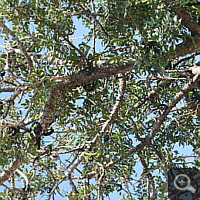Carob Tree (Ceratonia siliqua)
Overview
This member of the Legume family (Fabaceae) orinigates in Middle East and is also called Locust Bean tree or St. John’s-bread tree. As fruit is a longish pod produced which contains a smooth and aromatic fruit pulp. In that are numerous seeds embedded. In ancient times the seeds were used as weight unit for diamonds because they have a constant average weight of 200 mg. The word carat derives from the French le carat, which in turn derives from the Italian carato, which in turn traces back to the Greek word keration (that means approximately ‚little horn‘, as an allusion to the pod shape). Hereof the botanic genus name Ceratonia is derived from.
Description
In the meantime, Carob trees are widespread in the Mediterranean region, adapted to nutrient-poor and arid soils and reach the size of apple trees. The Carob tree has a expansive crown and a corky bark. The tree produces pinnate leaves, consisting of two to five facing leaves. The fresh budding is at first smooth and red, becomes later leathery with deep green colouring a though.
Culture
The culture is not difficult. A propagation from seeds is unproblematic. In the longer term the Carob tree can be grown to a little tree as pot plant. Only sparse water and fertiliser supply. The plant reacts sensitive on waterlogging, therefore mix the soil with ample sand and small stones water-permeable. In summer keep the plant outdoors, in winter overwinter the plant at a cool an light, but frost-free place. The carob tree tolerates only short slight frost.
Blossoms are only produced by older trees and thus are to be expected after seven years at the earliest.
Experiences
The Carob tree is undemanding. Good germination. Thereafter rather leisurely growth. Because of the very rough leaves Carob trees have only a low water demand. Also extended dry periods are survived without any problems by quite young plants, also in winter.
2010
The overwintering of my 2009 from seeds raised plant was without any problems. From the icemen to the first frosts in autumn the plant stood outdoors, where it showed a constant growth.
2011
The plant shows also this year a constant growth.

